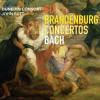Texte paru dans: / Appeared in:
*

GRAMOPHONE (Awards Issue /2013)
Pour s'abonner /
Subscription information
Linn
CKD430

0691062043021 (ID336)

Reviewer: David Vickers
Dunedin minus the voices for Butt’s Bach Brandenburgs
Expertly stylish recordings of the six concertos Bach presented in neat copy to the Margrave of Brandenburg in March 1721 are two-a-penny but the Dunedin Consort offer more substantial style and bona fide expertise than most. John Butt’s essay is an accessible commentary, narrated with a friendly authority that bespeaks his extensive academic and performing experience. Several choices reveal sincere reflection about how Bach might have expected such concertos to be played during his years of service at Cöthen, such as the use of low ‘Cammerton’ pitch (A=392) and Werkmeister III temperament, and a decision to tune the viola da gamba and violone grosso to ‘Chorton’ (ie up a third) in order to better exploit the sonorities of open strings. None of those principles would be quite so valuable if the music-making wasn’t charismatic and refreshing. About half of the revolving team of 20 have participated in high-profile recordings before but the Dunedin players forge their own identity and capture what Butt praises as ‘carefree, joyous and spontaneous works’.
The pair of horns and three oboes
in the opening of Concerto No 1 offer unforced conversational sparkle and the
French-style fourth movement is an eloquent courtly dance (particularly the
poignant trio for oboes and bassoon and compassionate strings in the Polacca).
In Concerto No 2 the concertante quartet of David Blackadder (trumpet), Pamela
Thorby (recorder), Alexandra Bellamy (oboe) and Cecilia Bernardini (violin) play
with an airy fluidity, with graceful natural trumpet leaving room for recorder
and oboe in the limelight. The nine-part strings in the dazzling finale of
Concerto No 3 (which Butt takes at quite a lick) suggest the extravagant flair
of Vivaldi’s L’estro armonico. The final Presto of Concerto No 4 is just one
example of Bernardini’s articulate bowing and relaxed phrasing in rapid
passages, and cellist Jonathan Manson and harpsichordist Butt provide continuo
with characterful joie de vivre. Butt plays a modern replica of a large Mietke
harpsichord like one purchased by the Cöthen court in 1719 and his flexible
performance of Bach’s cadenza in Concerto No 5 has a rare extemporised
atmosphere of exuberant fun; the amusement of the orchestra is almost tangible
in the closing ritornello. In contrast, the lower strings convey sublime
melancholy in the Adagio ma non tanto of Concerto No 6. Notwithstanding the
distinguished Brandenburg discography, this set is nothing short of sensational.
Fermer la fenêtre/Close window
Cliquez l'un ou l'autre
bouton pour découvrir bien d'autres critiques de CD
Click either button for many other reviews


